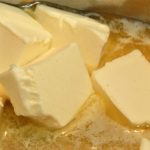 According to the Greek historian Herodotus, the ancient Scythians—a nomadic people of Asia and Eastern Europe—so loved butter that they used only blind slaves to churn it, ones who would not be distracted from their work by the outside world. The word butter, as befits the world’s first edible oil product, can be traced back thousands of years to the Greek bouturon, which the Greeks either borrowed from the Scythians or invented themselves by combining bous, meaning cow, and turns, meaning cheese. Bouturon was then adopted by Latin as butyrum, which evolved directly into the French beurre and, via the Germanic languages, into the English butter, first recorded in the eleventh century. The word butter ousted the previous Old English name of the oily spread: smeoru, the ancestor of the Modern English smear (also related to the Old English smeoru is the Modern Danish smor, meaning butter and appearing in smorgasbord). Incidentally, one of the two Greek words that evolved into butter—bous, meaning cow—persists in English as Bossy, a traditional name for a milk-cow.
According to the Greek historian Herodotus, the ancient Scythians—a nomadic people of Asia and Eastern Europe—so loved butter that they used only blind slaves to churn it, ones who would not be distracted from their work by the outside world. The word butter, as befits the world’s first edible oil product, can be traced back thousands of years to the Greek bouturon, which the Greeks either borrowed from the Scythians or invented themselves by combining bous, meaning cow, and turns, meaning cheese. Bouturon was then adopted by Latin as butyrum, which evolved directly into the French beurre and, via the Germanic languages, into the English butter, first recorded in the eleventh century. The word butter ousted the previous Old English name of the oily spread: smeoru, the ancestor of the Modern English smear (also related to the Old English smeoru is the Modern Danish smor, meaning butter and appearing in smorgasbord). Incidentally, one of the two Greek words that evolved into butter—bous, meaning cow—persists in English as Bossy, a traditional name for a milk-cow.
Butter is produced by churning cream under specific temperature conditions to separate the fat from the milk. Butter production can take place in a factory that adheres to government-mandated standards. Only butter made under such conditions is eligible to carry the USDA (United States Department of Agriculture) shield. These manufacturing facilities undergo periodic government inspections to ensure compliance with regulations. The quality of the butter is determined by a Department of Agriculture inspector, who evaluates its color, texture, and body. The grading system ensures that consumers receive high-quality butter that meets government standards.
Butter is produced by churning cream under specific temperature conditions to separate the fat from the milk. Butter production can take place in a factory that adheres to government-mandated standards. Only butter made under such conditions is eligible to carry the USDA (United States Department of Agriculture) shield. These manufacturing facilities undergo periodic government inspections to ensure compliance with regulations. The quality of the butter is determined by a Department of Agriculture inspector, who evaluates its color, texture, and body. The grading system ensures that consumers receive high-quality butter that meets government standards.
